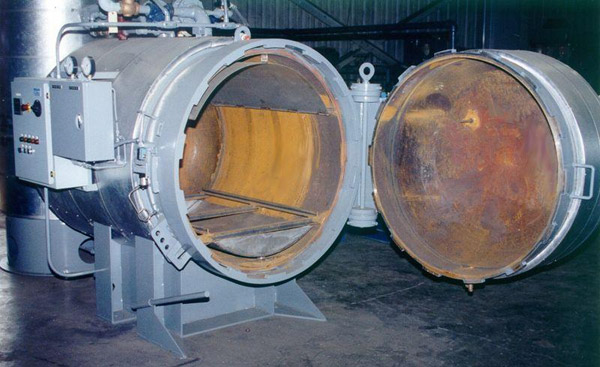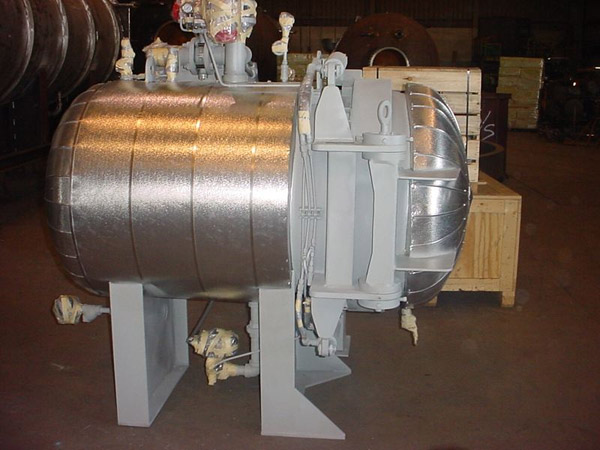


Product
Dewaxing Autoclaves
Design and fabrication of complete dewaxing systems that meet exact end user requirements is our specialty. From simple manually operated autoclaves to completely automated self-contained autoclaves, different types of systems are custom developed by us. Although autoclaves can be built to virtually any size, the common sizes that we produce range from 3′ to 6′ in diameter and 3′ to 8′ in length.
Each dewaxing autoclave is unique and warrants special attention in the preliminary design stage to ensure efficient operation, maintainability, and operational safety. For operational safety, we provide a unique door safety interlock mechanism, which uses redundant mechanical, electrical, hydraulic, and pneumatic devices. These devices offer complete protection against accidents such as opening of the door when high pressure builds up. Our autoclaves offer optimal performance even in the shortest cycle times.
Designed to suit your specific load and processing requirements, our dewaxing autoclaves also come with auxiliary support equipment such as a steam boilers and wet or dry steam accumulators. With extensive experience, we refine our standard design concepts to consistently provide a precision piece of equipment. Our steam-injected autoclaves are common in the industry and known for their user-friendly operation.
Dewaxing Autoclaves Specifications
Autoclave Specifications
Pressurizing Medium
Heating Methods
Autoclave Parts
Blower Motor
Circulating Fan
Cooling Coil Heat Exchanger
Quick Opening Door
Rupture Disc
Safety Relief Valve
Shielded Electrical Heating Unit
Standard Features
- Encapsulated blower motor eliminates the high maintenance necessary for through the vessel shaft sealing.
- Proprietary blower motor design allows operation at any combination of pressure and temperature.
- Engineered circulating fan assures excellent heat transfer to the load and exceptional temperature uniformity.
- Proprietary method of placing and securing insulation minimizes heat loss through the pressure vessel and minimizes operating costs.
- Location of typical electrical heating unit is shielded by cooling coil to prevent radiant heating of load.
- Cooling coil is a single pass heat exchanger designed for precise temperature control with ample provisions for thermal expansion to minimize thermally induced stresses and failure.
- “Man-Inside” emergency alarm cables are provided on larger autoclaves which allows operator to completely disable all autoclave sub-systems. It requires autoclave door to be opened to reset the alarm.
- Load track and floor is designed to allow for thermal expansion yet provide full structural support.
- ASME approved safety relief valve and rupture disc are provided on separate vessel penetrations to assure independent and safe operation. Many other redundant safeties are incorporated to assure operator and equipment protection.
- Most vessel penetrations, such as vacuum, thermocouple and cooling are built into removable and replaceable ANSI flanges. This allows easy modification or repairs without compromising the structural integrity of the vessel.
Harris Quick Opening Door Features
- This proprietary breech lock door allows full and easy access to the autoclave interior within one minute after completion of a curing cycle.
- Safety is inherent in its design, but we also include mechanical, hydraulic, electrical, and pneumatic interlocks to prevent door operation while the autoclave is pressurized.
- No relative motion of the door with respect to the pressure seal provides long o-ring life.
- An oxygen sensor/fresh air purge safety interlock is available to prevent opening the door unless safe levels of oxygen are present. This complies with recent OSHA rulings.
Capabilities
Services
Support Services
Instrumentation Options
Control Capabilities
Multiple Equipment Computer Control Monitoring
Recording with Backup
Control Options
Honeywell Computer Controls
Manual Controls
Network Compatible Computer-Based
Control Systems Programmable
Microprocessor-Based Controls Systems
Set Point Controls
Recording Options
Circular Chart
Computer
Data Logger Recorder
Strip Chart
Vacuum Control Types
Automatic
Manual
Vacuum Monitoring Options
Gauges
Transducers
Auxiliary Systems
Options Available
Vacuum Pumps
Lift Tables
Bridges
Load Carts
External Cooling System
Bridge Mechanism
Oxygen Sensor/Air Purge/Safety
Interlocks
